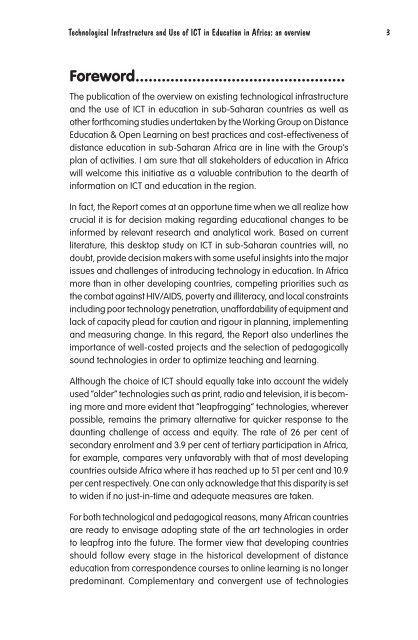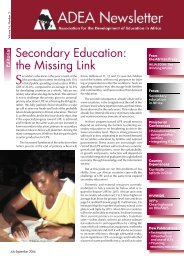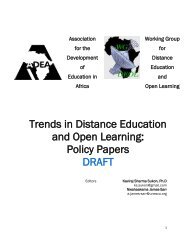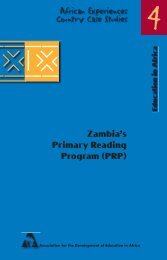Technological Infrastructure and Use of ICT in Education in ... - ADEA
Technological Infrastructure and Use of ICT in Education in ... - ADEA
Technological Infrastructure and Use of ICT in Education in ... - ADEA
Create successful ePaper yourself
Turn your PDF publications into a flip-book with our unique Google optimized e-Paper software.
<strong>Technological</strong> <strong>Infrastructure</strong> <strong>and</strong> <strong>Use</strong> <strong>of</strong> <strong>ICT</strong> <strong>in</strong> <strong>Education</strong> <strong>in</strong> Africa: an overview<br />
3<br />
Foreword................................................<br />
The publication <strong>of</strong> the overview on exist<strong>in</strong>g technological <strong>in</strong>frastructure<br />
<strong>and</strong> the use <strong>of</strong> <strong>ICT</strong> <strong>in</strong> education <strong>in</strong> sub-Saharan countries as well as<br />
other forthcom<strong>in</strong>g studies undertaken by the Work<strong>in</strong>g Group on Distance<br />
<strong>Education</strong> & Open Learn<strong>in</strong>g on best practices <strong>and</strong> cost-effectiveness <strong>of</strong><br />
distance education <strong>in</strong> sub-Saharan Africa are <strong>in</strong> l<strong>in</strong>e with the Group’s<br />
plan <strong>of</strong> activities. I am sure that all stakeholders <strong>of</strong> education <strong>in</strong> Africa<br />
will welcome this <strong>in</strong>itiative as a valuable contribution to the dearth <strong>of</strong><br />
<strong>in</strong>formation on <strong>ICT</strong> <strong>and</strong> education <strong>in</strong> the region.<br />
In fact, the Report comes at an opportune time when we all realize how<br />
crucial it is for decision mak<strong>in</strong>g regard<strong>in</strong>g educational changes to be<br />
<strong>in</strong>formed by relevant research <strong>and</strong> analytical work. Based on current<br />
literature, this desktop study on <strong>ICT</strong> <strong>in</strong> sub-Saharan countries will, no<br />
doubt, provide decision makers with some useful <strong>in</strong>sights <strong>in</strong>to the major<br />
issues <strong>and</strong> challenges <strong>of</strong> <strong>in</strong>troduc<strong>in</strong>g technology <strong>in</strong> education. In Africa<br />
more than <strong>in</strong> other develop<strong>in</strong>g countries, compet<strong>in</strong>g priorities such as<br />
the combat aga<strong>in</strong>st HIV/AIDS, poverty <strong>and</strong> illiteracy, <strong>and</strong> local constra<strong>in</strong>ts<br />
<strong>in</strong>clud<strong>in</strong>g poor technology penetration, unaffordability <strong>of</strong> equipment <strong>and</strong><br />
lack <strong>of</strong> capacity plead for caution <strong>and</strong> rigour <strong>in</strong> plann<strong>in</strong>g, implement<strong>in</strong>g<br />
<strong>and</strong> measur<strong>in</strong>g change. In this regard, the Report also underl<strong>in</strong>es the<br />
importance <strong>of</strong> well-costed projects <strong>and</strong> the selection <strong>of</strong> pedagogically<br />
sound technologies <strong>in</strong> order to optimize teach<strong>in</strong>g <strong>and</strong> learn<strong>in</strong>g.<br />
Although the choice <strong>of</strong> <strong>ICT</strong> should equally take <strong>in</strong>to account the widely<br />
used “older” technologies such as pr<strong>in</strong>t, radio <strong>and</strong> television, it is becom<strong>in</strong>g<br />
more <strong>and</strong> more evident that “leapfrogg<strong>in</strong>g” technologies, wherever<br />
possible, rema<strong>in</strong>s the primary alternative for quicker response to the<br />
daunt<strong>in</strong>g challenge <strong>of</strong> access <strong>and</strong> equity. The rate <strong>of</strong> 26 per cent <strong>of</strong><br />
secondary enrolment <strong>and</strong> 3.9 per cent <strong>of</strong> tertiary participation <strong>in</strong> Africa,<br />
for example, compares very unfavorably with that <strong>of</strong> most develop<strong>in</strong>g<br />
countries outside Africa where it has reached up to 51 per cent <strong>and</strong> 10.9<br />
per cent respectively. One can only acknowledge that this disparity is set<br />
to widen if no just-<strong>in</strong>-time <strong>and</strong> adequate measures are taken.<br />
For both technological <strong>and</strong> pedagogical reasons, many African countries<br />
are ready to envisage adopt<strong>in</strong>g state <strong>of</strong> the art technologies <strong>in</strong> order<br />
to leapfrog <strong>in</strong>to the future. The former view that develop<strong>in</strong>g countries<br />
should follow every stage <strong>in</strong> the historical development <strong>of</strong> distance<br />
education from correspondence courses to onl<strong>in</strong>e learn<strong>in</strong>g is no longer<br />
predom<strong>in</strong>ant. Complementary <strong>and</strong> convergent use <strong>of</strong> technologies

















